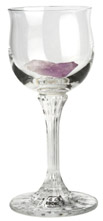Discover methods of creating a spiritually cleansing and fortifying drink using the positive benefits of your crystals. Learn which crystals are potentially toxic and what steps to take when dealing with toxic crystals.
 To prepare crystal water, start with a clean clear glass jug, bowl, or jam jar with a glass lid. Don't use coloured glass, as each colour has a vibration of its own, and this will have an effect on the remedy. Also don't use plastic, as chemicals from the plastic can leach out into the water. Besides, the main constituent of glass is clear quartz! Also wash the crystal you intend to use, and make sure it is cleansed energetically.
To prepare crystal water, start with a clean clear glass jug, bowl, or jam jar with a glass lid. Don't use coloured glass, as each colour has a vibration of its own, and this will have an effect on the remedy. Also don't use plastic, as chemicals from the plastic can leach out into the water. Besides, the main constituent of glass is clear quartz! Also wash the crystal you intend to use, and make sure it is cleansed energetically.
Place the selected crystal (or crystals) in the jug or jar and fill it with water. At one time it would have been considered best to use pure spring water, but because of widespread pollution and dubious methods of bottling, plus the environmental implications of processing the water, added pollution from the plastic it is usually bottled in, and the miles it has to travel to reach us, it is probably better to use filtered tap water.
Cover the jug or seal the jar, preferably with a clear glass plate, to keep out any impurities, and place either outside or in a sunny window, so the light will enhance the energy of the crystal. The effect can be further strengthened by placing a clear quartz cluster on top, and placing 3 or 5 small clear quartz points around the jug with the terminations (points) pointing towards it. Some recommend that the water be energised in sunlight for around 12 hours; others suggest 24 hours in both sunlight and moonlight. Either way, don't be too concerned if it's a cloudy day - the energy will still get through.
Experiment, starting with clear quartz to see which method suits you. Try a taste test between unfiltered tap water that has been treated this way and ordinary tap water. Once you get the hang of it, try other crystals, but remember that a few of these may be toxic, so if in doubt, use the secondary method.
This method is much the same as the main method, but uses a clear glass bowl, plate, and a tall-sided drinking glass. Place the crystal in the drinking glass, and place that in the bowl. Fill the bowl with water, but not up to the top of the glass, and place the plate over the top. This allows the vibration of the crystal to reach the water without placing the crystal in direct physical contact with it.
Gem elixirs are prepared in the same way as crystal waters, but can be stored for long periods of time, to be used when needed. Sterilise the glass and the water by boiling before preparation, if possible. When the crystal water is ready, blend with at least 50% brandy and bottle in small lightproof dropper bottles. Use 3-5 drops of elixir in water or juice and sip, three times a day.
When experimenting with these essences, please be sensible! Make sure the crystal isn't toxic before preparing an elixir or crystal water by the main method, think about why you have chosen your particular crystal, and also, if you do not know what affect it will have, take only a few drops at a time. You are working with a powerful tool!
Most poisonous minerals will probably not be harmful when handled, and even when used in a gem elixir, as so little of the substance actually enters either the skin or water. However, it is advisable to avoid direct contact with them, especially when using them for a gem elixir. Use the secondary method of preparation. If unsure of toxicity, consult the chemical formula. Most mineral guides will give the chemical formula along with the information on the mineral.
The following is a rough guide to potentially toxic minerals:
Author: Janelle Scialla